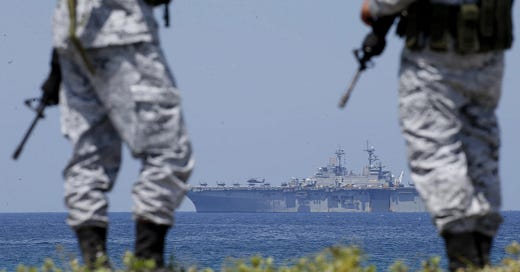The top U.S. international news today is all about China. On cable, the big story is the Chinese “spy balloon” spotted over Montana. (“Does it pose a significantly enhanced threat on the intelligence side? Our best assessment right now is that it does not,” an anonymous senior defense official told various outlets, who granted them anonymity just because.)
In print, the attention is on a more substantive announcement: Biden’s plan to, as the New York Times puts it: “Deter China With Greater U.S. Military Presence in Philippines.” Specifically, the Philippines has agreed to allow the U.S. military to use and expand up to nine bases on its soil, for the purpose of “constrain[ing] China’s armed forces and bolstering [the U.S.’s] ability to defend Taiwan.”
Now let’s say that you, like most Americans, are only vaguely familiar with this place — the Philippines. And that all the information and context you have is what you can glean from the coverage of this announcement.
You would suspect, first off, these “Philippines” must be near mainland China and Taiwan — otherwise what would the point of building bases there be?
And indeed, the Times confirms, in the tenth paragraph:
The archipelago of the Philippines lies in an arc south of Taiwan, and the bases there would be critical launch and resupply points in a war with China. The Philippines’ northernmost island of Itbayat is less than 100 miles from Taiwan.
Ah, of course, it’s a bunch of islands. Hence the plural. Philippines.
OK, so is this new? Scanning down to the nineteenth paragraph: “The last American soldiers left the Philippines in the 1990s, and the country’s Constitution now bars foreign troops from being permanently based there.”
Hmm. OK, well, sounds like they didn’t leave under particularly good terms. But wait, you might ask, what were U.S. troops doing in the Philippines in the first place? I mean, sure, there are just always American troops everywhere in the world. The Times notes, in passing, toward the end of the piece “other parts of the world where U.S. forces are temporarily based, such as in Iraq, Syria and Somalia” — as if that’s just the natural order of things.
But we know why U.S. troops are those three places. Or at least, we mostly remember the initial wars that got them there. So why were there in the Philippines, and why is the Filipino government now welcoming them back? The Times article doesn’t say.
All right, well, what about the Washington Post? There’s a quote from Philippine President Ferdinand Marcos Jr., greeting U.S. Defense Secretary Lloyd J. Austin III:
“The United States has always been our longest partner and ally,” Marcos said. “I have always said, it seems to me that the future of the Philippines, and for that matter the Asia-Pacific region, will always involve the United States.”
Ferdinand Marcos, hmm, where have you heard that name before? But anyway, that doesn’t really answer the question, does it? When did this loving relationship start? And how?
Ah, there’s another clue, in the twenty-fifth paragraph:
The Philippines, once a U.S. territory, has been a treaty ally since 1951. It hosted a massive U.S. presence after World War II, including two of the largest American military facilities overseas — an arrangement that ended in 1991 when the Philippine Senate, asserting the country’s sovereignty was being violated, forced the United States to relinquish all its bases.
Now we’re getting somewhere. It was a “territory”! But what kind of territory? And did this start after World War II, or were the bases already there? Alas, that’s it, that’s all the information included. Maybe the Wall Street Journal can clue us in?
The Philippines is Washington’s oldest defense ally in Asia. The Southeast Asian nation once hosted two of the largest American military installations outside the U.S.—Clark Air Base and Subic Bay Naval Base. Both were shut down in the early 1990s, after Philippine senators voted not to renew U.S. privileges.
Damn, even less helpful.
NPR?
Many Filipinos have expressed weariness about letting more U.S. servicemen be stationed in the Philippines again. The last U.S. military bases were dismantled in 1992 …
Nope.
Wait, perhaps you just remembered where you heard that name before: Ferdinand Marcos was the dictator of the Philippines — the corrupt, murderous leader who ruled that country with an iron fist for over twenty years, from 1965 until 1986. Ronald Reagan was a fan of his. Ferdinand Junior is his son. Though you wouldn’t know that from any of the three articles we’ve scanned so far.
All right, forget the mainstream media. Maybe the right-wing press will shed some light on this question.
But, no, nothing at all about a past U.S. presence in the Fox News story. Let’s look deeper: a few weeks ago, “comedian” (?) Jesse Watters, did a segment laying into Kamala Harris for a trip she




